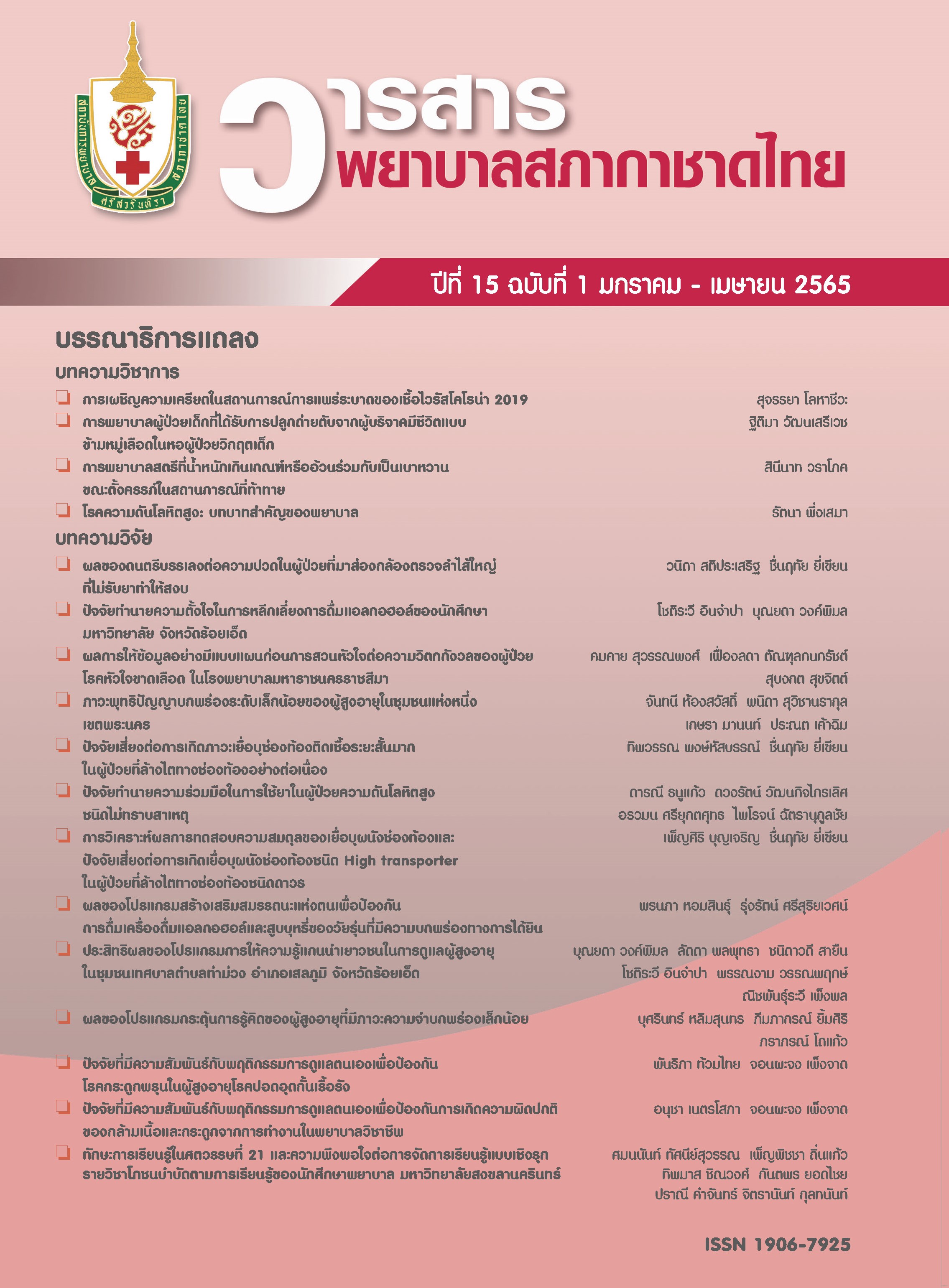Risk Factors of Very Early-Onset Peritonitis in Patients Underwent Continuous Ambulatory Peritoneal Dialysis
Keywords:
end stage renal diseases, continuous ambulatory peritonsal dialysis, peritonitis, risk factors of very early-onset peritonitisAbstract
Peritonitis is one of the most serious problems of CAPD patients. This analytical study was conducted to examine the risk factors of very early-onset peritonitis (VEOP) in ESRD patients who underwent CAPD. The factors were 1) medical conditions, 2) process of doing CAPD, 3) social and environment and 4) infections. The purposive samples were patients who underwent CAPD and had a first episode of peritonitis at Hemodialysis unit of Queen Savang Vadhana Memorial Hospital from 2014 to 2019. Data were collected by the constructed record form. Its validity was checked by the five experts. Its reliability was tested by test-retest method with a ninety-eight percent agreement. Data were analyzed using descriptive statistics. Chi-square test was used to compare the percentages between the two groups. The risk factors were analyzed by binary logistic regression.
There were 164 samples which were divided into two groups. Those were 32 and 132 cases in VEOP within 90 days and more than 90 days groups, respectively. Most of the patients were aged 40 - 60 years. The demographic data of the two groups were not different in terms of age, gender, education, and income. However, the VEOP within 90 days group had a significantly greater percentage of single/widow status than those of the more than 90 days group (p = .004). The significant risk factors of VEOP were Hct £ 30%, FBS > 140 mg/dl, and K £ 3 mEq/L, respectively.
This study recommended assessing the risk factors of VEOP from blood test results in all new CAPD cases. Those were Hct £ 30%, FBS > 140 msg/dl, and K £ 3 mEq/L. The patients who had abnormal of those blood test needed for counseling from a multidisciplinary team in order to improve their medical conditions before starsing CAPD. Also, after initial CAPD, follow up at the first and second weeks and telephone counseling should be done.
References
LuoQ, Xia X, Lin Z, Lin J, Yang Y, Huang F, Yu X. Very early withdrawal from treatment in patients starting peritoneal dialysis. Ren Fail 2018;40(1):8–14.
Thanakitjaru P. Current situation of chronic kidney disease in Thailand. Journal of the Department of Medical Service 2015;40(5):5-17. (in Thai)
Tiawilai T, Tantivichivej R. The incidence and risk factors of first peritonitis episode in continuous ambulatory peritoneal dialysis patients of Photharam hospital. Region 4-5 Medical Journal 2020;39(1):51-64. (in Thai)
Li PKT, Szeto CC, Piraino B, de Arteaga J, Fan S, Figueiredo AE, et al. ISPD Peritonitis recommendations: 2016 update on prevention and treatment. Perit Dial Int 2016;36(5):481–508.
Poltacha S, Noktong S, Changjeraja W. Factors related with peritonitis in CAPD patients at Buengkan Hospital. Nursing, Health, and Education Journal 2018;1(3):3-10. (in Thai)
Tungkasereerak P. The prognostic factors of recurrent peritonitis in CAPD patients. Srinagarind Med J 2017;32(6):519-23. (in Thai)
Sangsa N. Factors associated with bacterial peritonitis of patients with chronic renal failure with continuous ambulatory peritoneal dialysis. Mahasarakham Hospital Journal 2018;15(2):44-56. (in Thai)
Kolesnyk I, Dekker FW, Boeschoten EW, KredietRT. Time-dependent reasons for peritoneal dialysistechnique failure and mortality. Perit Dial Int 2010;30:170–7.
Guest S, Hayes AC, Story K, Davis ID. Peritoneal dialysistechnique successduring the initial 90 days of therapy. Adv Perit Dial 2012;28:60-63.
Ma X, Shi Y, Tao M, Jiang X, Wang Y, Zang X, et al. Analysis ofrisk factors and outcome in peritoneal dialysis patients with early-onset peritonitis: a multicenter, retrospective cohort study. BMJ Open 2020;10(2):e029949. doi: 10.1136/bmjopen-2019-029949.
Tian X, Xie X, Xianga S, Yanga X, Lina J, Zhang X, et al. Risk factors and outcomes of early-onset peritonitis in Chinese peritoneal dialysis patients.Kidney Blood Press Res 2017;42(6):1266-76.
The Nephrology Society of Thailand. Clinical practice guideline (CPG) for peritoneal dialysis 2017. Bangkok: The Nephrology Society of Thailand; 2018. (in Thai)
De Sousa A. Client centered therapy. Indian J Appl Res [Internet]. 2014 [cited 2021 Apr 24];4(2):10-3. Available from: https://www.worldwidejournals.com/indian-journal-of-applied-research- (IJAR)/fileview/February_2014_1391259431_6894d_133.pdf
Biggs A. Orem’s self-care deficit nursing theory: update on the state of the art and science. Nurs Sci Q 2018;21(3):200-6.
He P, Hu JP, Li H, Tian XJ, He LJ, Sun SR, et al. Red blood cell distribution width and peritoneal dialysis-associated peritonitis prognosis. Ren Fail 2020;42(1):613-21.
Berbudi A, Rahmadika N, Tjahjadi AI, Ruslami R. Type 2 Diabetes and its impact on the immune system. Curr Diabetes Rev 2020;16(5):442-9.
Nakai K, Saito K, Fujii H, Nishi S. Impact of hypokalemia on peritonitis in peritoneal dialysis patients: a systematic review. Ren Replace Ther 2017;3:43. doi 10.1186/s41100-017-0128-5
Kaitwatcharachai S, Kaitwatcharachai C. Risk factors for developing first episode of peritonitis in patients undergoing CAPD. J Med Health Sci 2012;19(3):29-35. (in Thai)
Peaschpunpaisal C, Leaungsomnapa Y, Chanthapech R, Pangsree S. Self-management for preventing peritonitis at least 18 months in patients with continuous ambulatory peritoneal
dialysis (CAPD). Journal of Phrapokklao Nursing College 2018;29(1):17-28. (in Thai)
Downloads
Published
Issue
Section
License
Copyright (c) 2022 Srisavarindhira Thai Red Cross Institute of Nursing

This work is licensed under a Creative Commons Attribution-NonCommercial-NoDerivatives 4.0 International License.
เนื้อหาบทความหรือข้อคิดเห็นต่างๆ ในวารสารพยาบาลสภากาชาดไทยนี้ เป็นความคิดเห็นของผู้เขียนบทความ ไม่ใช่ความเห็นของกองบรรณาธิการ หรือสถาบันการพยาบาลศรีสวรินทิรา สภากาชาดไทย






